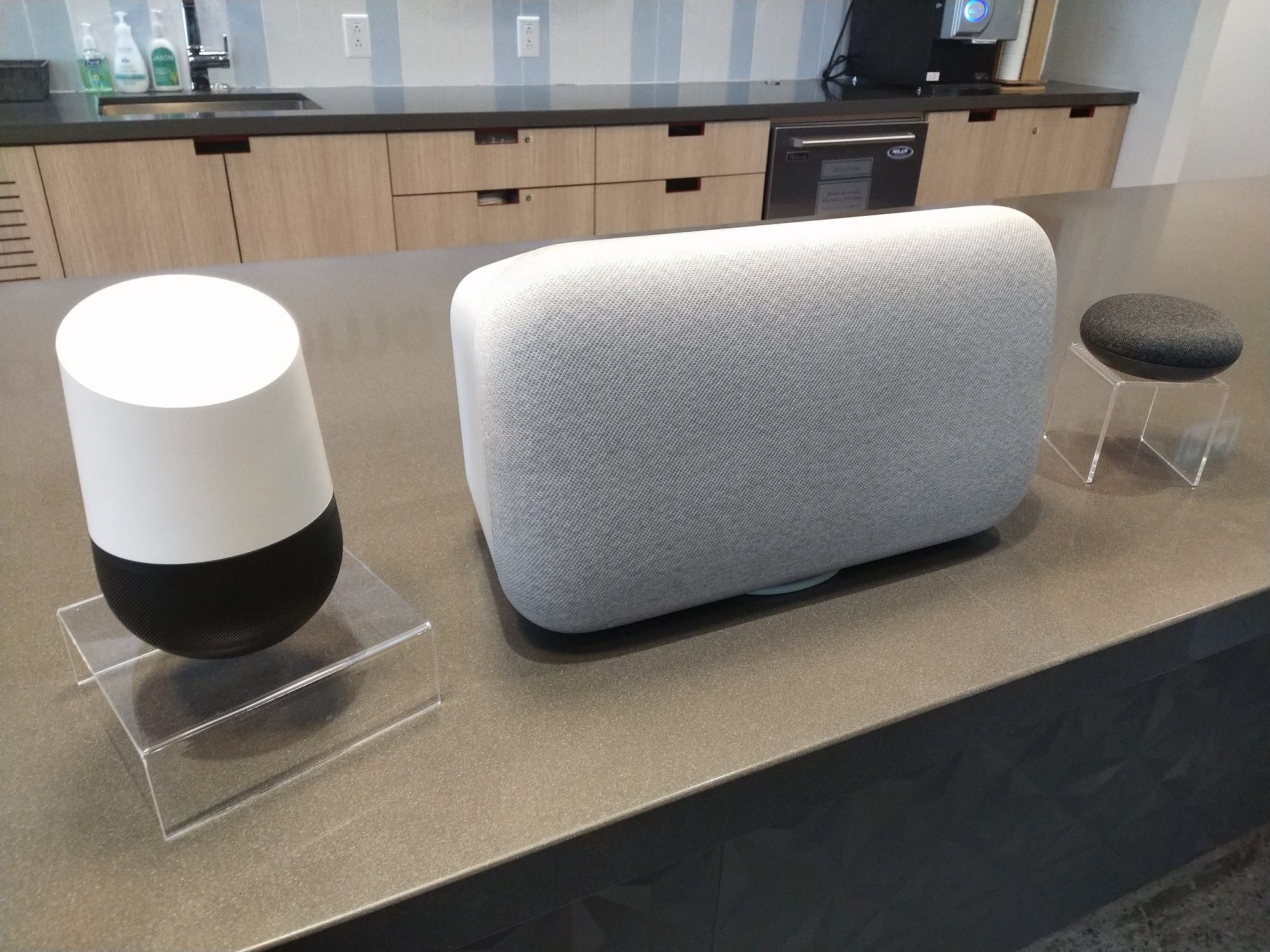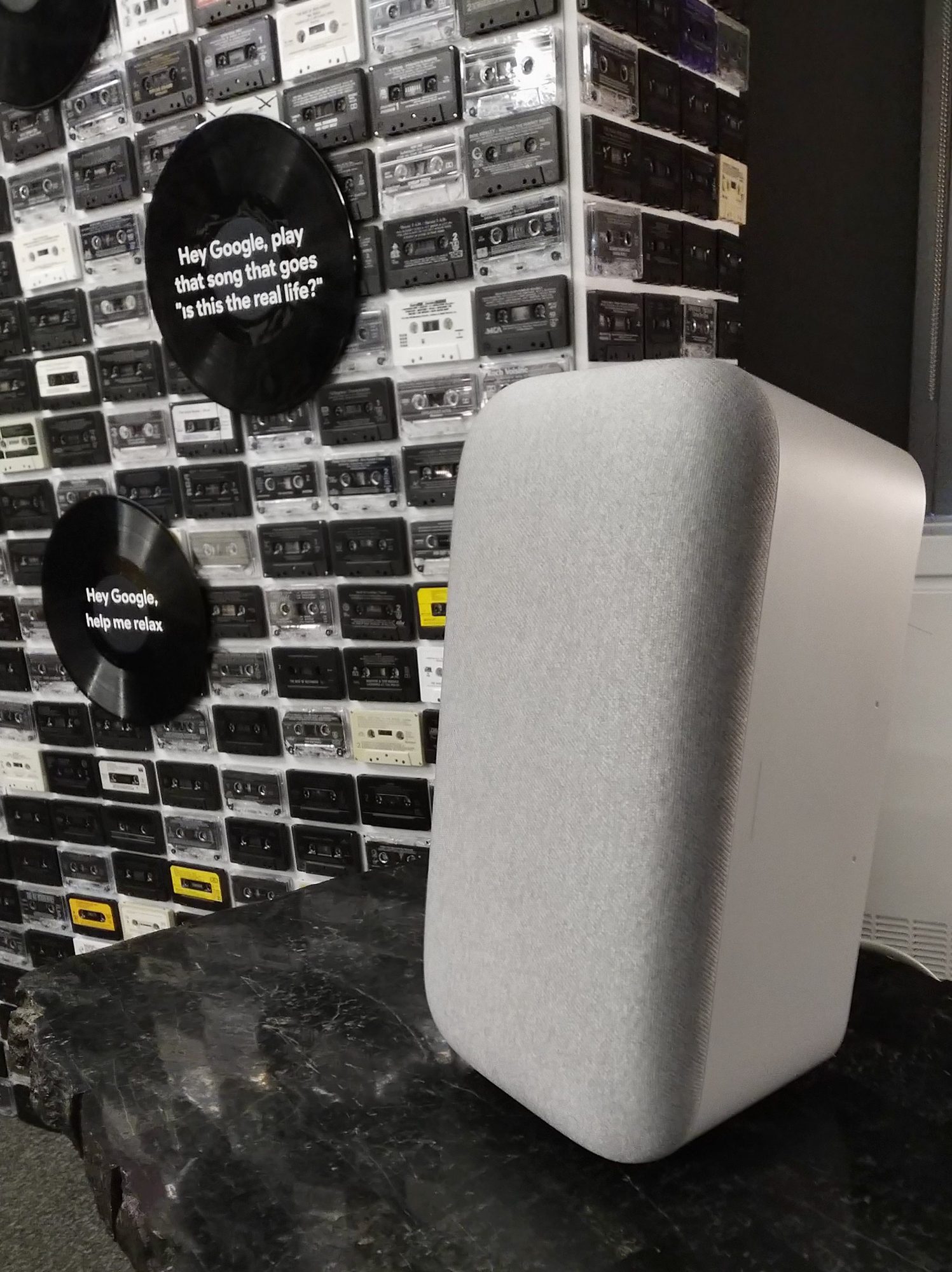The Google Home Max is my new TV soundbar, thanks to the simple inclusion of the 3.5mm aux audio input that’s included on this device.
I’ve bemoaned the loss of the headphone jack (an aux output) on many new smartphone designs in the past, and I think that the usefulness of this input port on the Google Home Max proves my point that despite being analog technology, these jacks are useful and worth including. But I digress, so back to our review of the Google Home Max.
As we reported last week, the latest and biggest addition to Google’s smart speaker family is available in Canada as of today, May 16 and it’s on sale for $499 from the Google Store and Best Buy Canada. It joins the original Google Home and the Google Home Mini as the latest addition to the family of speakers with built-in Google Assistant made by Google (or should I write that #madebygoogle ?). It’s available in charcoal or chalk colours.

Looking at this in the competitive market, Google Home Max squares up against the Apple Homepod in terms of price and performance. But only consumers in the U.S. have that choice to make right now, as Homepod hasn’t been made available in Canada yet. (Though you can use it here and we’ll have a video about that soon.) It’s also competitive with the Sonos family of smart speakers, which now includes the Sonos One with built-in Alexa (and presumably soon enough, Google Assistant as well.)
Since the Google Home Max has been available in the U.S. for some time, it’s been well reviewed by many tech writers. So I’m not going to write about how well its polycarbonate frame handles the powerful and distortion-free bass this speaker is capable of, or how it nicely separates the left and right channels across a room, or how it’s the first speaker with Smart Sound from Google that uses machine learning to “listen” to reverberation from its surrounding environment to adapt accordingly.

Plus, it has the same Google Assistant integration that we’ve described in our deep dive look at the Google Home. So I won’t remind you about about how this device can play your personalised music libraries from Spotify or Google Play, or connect to Chromecast devices on your network to stream Netflix and Youtube to your TV via voice command, or control your smart home lighting, or play Hashtag Trending in your daily briefing, or make phone calls, or connect with If This Than That, or broadcast a message across multiple speakers, and so on. That’s what hyperlinks are for.
Instead, I’m going to tell you about how Google Home Max is my new soundbar.
Using Google Home Max as a soundbar
Here’s my entertainment system setup: I’ve got a 43-inch Philips 4K UHD TV. It has an aux output that’s feeding into Google Home Max and I’m using that as the only sound output. I have the option of turning up the TV’s built-in speakers to use in conjunction with the Max, but I find this just muddles the sound.
The TV has Chromecast built-in, and I have a Windows PC and an Xbox One X connected to it. All of these systems feed their audio through the TV and it passes it to the Max, and it handles it all just beautifully. My previous audio setup was to use the TV’s speakers as a centre channel, amplified by a Bose Companion 20 multimedia speaker system for left and right channels. The Bose speakers were good and provided decent bass, but I found that there was a big gap between quiet dialogue scenes and loud action scenes. As a result, I had the habit of scrambling to adjust the volume often.

Not so with the Max. It really delivers clean and crisp dialogue and then nicely transitions to booming action scenes. The stereo separation on the one Max speaker isn’t fantastic, as the two 4.5-inch speakers are right next to each other. If you buy two Max speakers, it’s possible to connect them wirelessly as a stereo pair. I wasn’t able to test this.
Apparently the aux input sound on the Max suffered from a fraction-of-a-second delay before an update was delivered exactly one week ago fixing this. It’s a good thing for me, because having the video out of sync with the audio would have been a deal breaker for use as a soundbar. But with the fix in place, I’ve been in the clear.
Aside from sounding great, the Max is able to juggle both being a smart speaker and playing audio from the aux input. There are no problems making voice requests via the Max while it’s handling aux audio input. The speaker will prioritize audio playing natively from Max over audio from the aux input at all times. Here’s a few examples of this in action:
- If you’re watching TV and ask for the weather, the Max will mute the audio from the TV and tell you the weather, then resume the audio at the same volume when the weather request is completed.
- If you’re listening to Spotify on Max and then start playing your TV via the aux input, the Max will continue to play music from Spotify and not play the aux input. Once you stop the music from Spotify using a voice request or the Google Home app, you’ll hear the TV.
- If you’re watching TV and you ask for music from Spotify to start playing, you’ll hear the music from Spotify and not the TV. This will continue until you stop Spotify.
With my setup, what’s nice is since I have Chromecast integration with my TV, I can ask for a video from Netflix or Youtube to play and the sound will come through the Max. I can even ask for Spotify to be played on my TV so that I can listen to it through the Max, and see album art and song details on the TV. It’s a pleasing synergy.
The options to use the Home app to see what source is currently playing audio can be useful. Also to control volume with more precision, and in the case that the sound from Max is overpowering your voice requests (this can happen, although Google makes a point of saying it trys to prevent it.) You can also adjust treble and bass in the equalizer settings to your preference.
The Max isn’t perfect as a soundbar. I discovered a quirky interaction between the Chromecast integrated in my TV when the Max speaker is connected to the aux output. I can use voice requests via Google Home to start videos from Netflix and Youtube, but not pause them, stop them, or jump around on the timeline. I suspect this is a bug related to the Max playing the audio from another Chromecast device. In any case, I can still use the Home app to access these functions.
Since there’s only a single aux input available, it can’t be integrated into a surround sound setup. A semi-mysterious USB-C port on the back makes you wonder if that could change through an adapter. At present, the best guidance I can find on the purpose of this port is from a Google Home Help Forum, where an answer indicates it’s to allow for Ethernet connections via an adapter. It can also be used to charge your phone, if you’re so inclined.
Conclusion
Overall I’m pleased that Google made some design choices to make this speaker versatile. The choice to include a simple aux input means you can integrate this device to your TV, or even the legacy audio equipment you’re hanging onto at home like an LP player. These are features that other smart speakers at a similar price point have elected to exclude.
If you demand great music quality and you’re interested in a smart speaker, this is an expensive purchase but a worthwhile one. It will connect nicely with your other Google Home hardware in multi-room setups and likely with the rest of your smart home gear.
If you already have great speakers at home, you probably don’t need this. Buy something like a Chromecast Audio device to connect it and add a Google Home Mini for voice controls and you’re set for much less money.
But if you do need a booming new speaker and you like the smart assistant aspect, this is the speaker to buy in this category in Canada. Maybe it’ll find a home as your new soundbar.
